5 Best Yoga Mudras For Asthma With Steps & Benefits
A step-by-step guide to help you practice yoga poses beneficial for this respiratory ailment

Image: Shutterstock
Asthma makes you uncomfortable and uneasy. The shortness of breath weakens your body, dulls your spirit, and slows down your brain. Luckily, there are certain yoga mudras for asthma management that you can rely on. Here, we discuss them, how to perform them, and their overall health benefits. Keep scrolling to find out.
Before that, let’s understand the importance of yoga mudras as healing agents.
In This Article
Significance Of Yoga Mudras
Yoga mudras are an independent branch of yoga, apart from asanas and breathing techniques.
Mudra means gesture or attitude, and it connects one body part to another. A mudra might involve your entire body or just your hand. There are five kinds of yoga mudras – Hasta (hand) mudras, Mana (head) mudras, Kaya (posture) mudras, Bandha (lock) mudras, and Adhara (perineal) mudras. These mudras initiate currents through the body, balancing the body’s elements and restoring them.
Yoga mudras balance the five life-sustaining elements (fire, water, wind, sky, and earth) in your body and cure diseases caused as a result of an imbalance in these five elements. Hasta mudras are more familiar than the others, and your fingers in the hand mudras represent the five life-sustaining energies in the body. They serve as electrical connections to the body, and their placement adjusts the flow of energy, invoking the five life energies to carry out their specific functions accurately.
Key Takeaways
- Yoga mudras are a distinct area of yoga, besides postures and breathing exercises.
- Asthma Mudra treats and eliminates asthma attacks.
- Bronchial Mudra assists you to get rid of chest congestion and bronchitis.
- Prithvi Mudra boosts the earth element in the body and imparts strength to your immune system.
- Linga Mudra maintains your respiratory system and eliminates mucus from your windpipe.
- Surya Mudra helps to treat a bad cold and blocked nose.
Hasta Yoga Mudras For Asthma
There are a set of 16 hand mudras that help in healing various ailments of your body. These mudras can be practiced while sitting, standing or even walking. You need to ensure the mudras are symmetrical and your body is relaxed.
Some of the hasta mudras effectively regulate oxygen intake, clear the bronchial tubesi Also called bronchi or airways, these pipes let air move in and out of the lungs during the breathing process. , and ease breathing. Those hand mudras are mentioned below, and regularly practicing them will give relief from asthma.
An Indian yoga training teacher talks about how they incorporated mudras to ease their own asthma while on a hiking experience. “I was very tired and had met a number of people on horseback (I react allergically to the smell of horses), as well as blossoming trees, during the last three miles. This was enough to cause an asthma attack. I did Mudra Number 4 (asthma mudra), and after four minutes, my breathing was back to normal. I also frequently use Mudra Number 5 (bronchial mudra) when I notice that my chest has become constricted (i),” they say.
So without further ado, let’s learn how to perform these wonderful mudras to clear aerial passageways.
Asthma Curing Hasta Mudras
Regular practice of these hasta mudras can help manage asthma effectively by reducing symptoms while improving traditional medical treatments. Out of the all yoga mudras for ailments, the following five mudras may help you with asthma and its symptoms.
1. Asthma Mudra
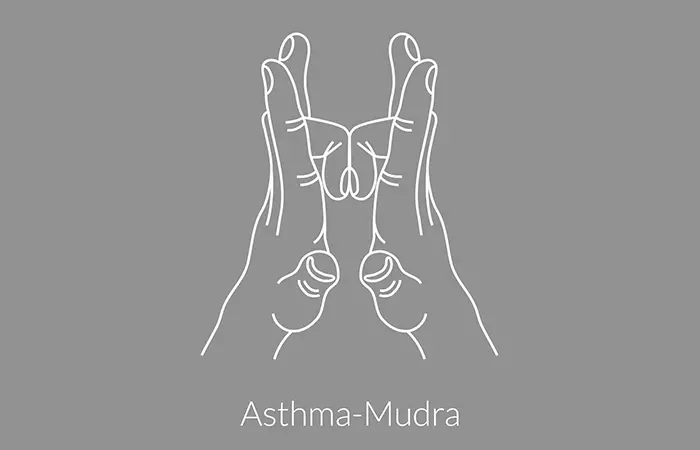
Benefits: Asthma Mudra relieves and prevents asthma attacks.
Procedure: Bring your palms together. Bend the middle fingers of both the hands in such a manner that the upper halves of both the fingers are lowered, and the nails of the bent middle fingers are pressed against each other. The other fingers are kept at a distance from each other, and the palms are slightly apart. Practice the mudra for 7-10 minutes every day.
 Quick Tip
Quick Tip2. Bronchial Mudra

Benefits: This mudra helps you get rid of chest congestion and bronchitisi Inflammation of the lining of bronchial tubes that carry air in and out of the lungs, mostly caused by viral infections. . It is a natural, life-saving treatment during an asthma attack.
Procedure: Open up your palm. Place your little finger at the base of your thumb and your ring finger at the upper thumb joint. Then, put your middle finger on the thumb’s pad. Leave the index finger extended outwards. Practice this mudra for about 5 minutes every day.
3. Prithvi Mudra
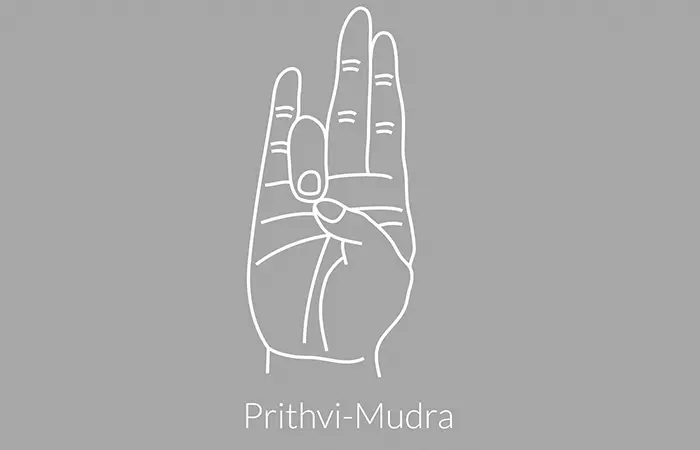
Benefits: This mudra increases the earth element in your body and boosts your immune system.
Procedure: Sit comfortably either in the Padmasana or Vajrasana or on a chair. Let the tip of your ring finger touch the tip of your thumb. Apply gentle pressure while doing so. The other fingers have to be kept straight and taut. Practicing this mudra for 30-45 minutes every day is good.
 Quick Tip
Quick Tip4. Linga Mudra
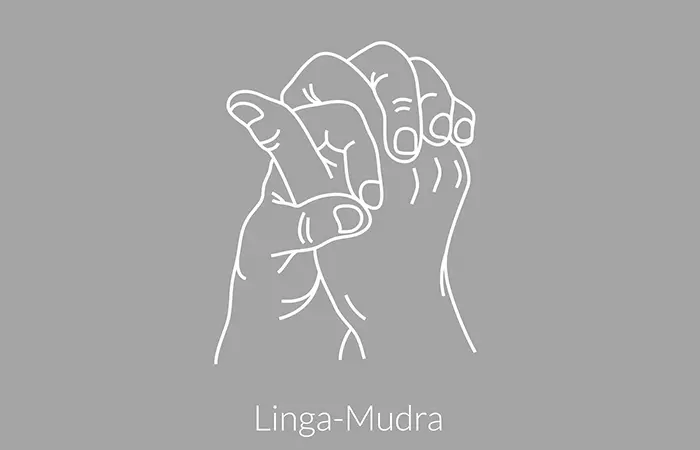
Benefits: This chest opening mudra keeps your respiratory system intact and clears phlegmi Mucus that comes out of the respiratory tract, which is thicker due to illness and is usually not a serious health issue. from your windpipe.
Procedure: Sit or stand comfortably. Clasp your hands in such a manner that your fingers are intertwined. Place it near your chest. Point your left thumb upward and encircle your left thumb with the right thumb and right index finger. Maintain the mudra intact for 15 minutes while breathing normally.
5. Surya Mudra
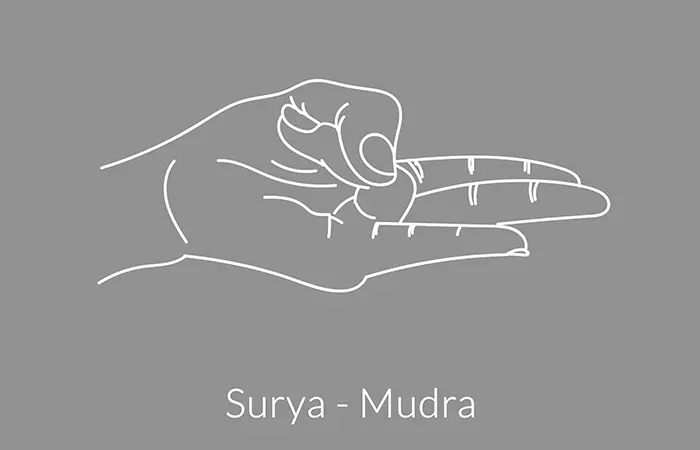
This mudra is useful to cure severe cold and nose blockage.
Procedure: Sit or stand in a comfortable position. Bring your hands in front of your chest. Keep your palms open and facing outward. Now, keep the tip of your index fingers of both the hands at the base of your thumbs and place the thumbs on top of the index fingers. Make sure the other fingers are straight and kept together. Retain the mudra for about 15 minutes. Do it thrice a day.
Some breathing techniques, in addition to Hasta Yoga Mudras, can be very helpful in controlling asthma symptoms by enhancing lung function and lowering breathlessness. Scroll down to know more in detail.
Breathing Techniques For Asthma
Here are some effective breathing techniques for asthma:
- Try diaphragmatic breathing, often referred to as belly breathing. This method focuses on using the diaphragm to breathe effectively and deeply. Put one hand on your chest and the other on your abdomen to practice. Take a deep breath through your nose, keeping your chest motionless and letting your abdomen rise. Breathe out slowly through your lips, allowing your belly to drop. To enhance breathing control, repeat for five to ten minutes per day.
- Using the Buteyko breathing technique, you can lessen hyperventilation by taking shallow breaths. Take a comfortable seat, inhale deeply through your nose, and then slowly exhale. Hold your breath for a short while after you’ve exhaled, then take another breath. People with asthma can lessen their breathing difficulties by practicing Buteyko breathing.
- Pursed lip breathing slows breathing and prolongs airway opening, which helps manage breathlessness. Take a slow, nasal breath to start. Then, as if you were blowing out a candle, slowly exhale through pursed lips. To promote easier breathing and encourage relaxation, try to make the exhale twice as long as the inhale.
- The breath counting method eases anxiety related to asthma and encourages relaxation. To begin, inhale deeply, then slowly exhale while silently counting each breath. To help you relax and lessen the feeling of being out of breath, keep counting for five to ten minutes.
Infographic: Hasta Mudras That Can Help Manage Asthma
Hasta mudras relieve chest congestion, remove phlegm from the windpipe and clear any lung obstructions, increase lung capacity, and help in breath control– all of which improve the respiratory system’s function in people with asthma. You can learn more about these simple hasta mudras that have great healing properties and offer relaxation in the infographic below.
Some thing wrong with infographic shortcode. please verify shortcode syntax
Respiratory conditions, especially asthma or allergies that cause breathlessness, can make life difficult. So, taking to yoga for asthma inflammation is one of the most sought-after ways to manage this ailment. The five yoga mudras listed above can address the imbalances in life-sustaining elements like water, air, fire, earth, and sky in the body and help in prevention and treatment of resultant illnesses. Of the five mudras, hasta mudras work effectively to prevent asthma attacks, ease chest congestion, boost immunity, remove phlegm from the windpipe, and treat severe cold and nose blockages. These easy-to-perform hasta mudras have great healing properties, and you can even practice them while at work or traveling. Along with that it’s important to practice self-care and make some lifestyle changes such as eating a healthy diet and exercising regularly. Moreover, indulging in yoga or any form of physical activity can help in stress reduction, improves endurance, flexibility, fitness levels, and wellness. You can also practice meditation to increase mindfulness and improve holistic health. In addition to this, you may also try some home remedies for asthma, such as honey and turmeric. However, before using them, always consult your healthcare specialist.
Now, let’s answer some queries regarding yoga mudras and asthma.
Frequently Asked Questions
Can you die from an asthma attack?
Yes, it is possible to die from an asthma attack when proper care is not taken and when one is not vigilant to worsening symptoms.
What first aid to follow during an asthma attack?
When you get an asthma attack, try to sit upright immediately, loosen your clothes and use your inhaler.
Can asthma be completely cured?
Though asthma cannot be completely cured, it is possible to treat and control the symptoms. This will save the patient from regular bouts of coughing and breathing difficulties.
What are the common triggers of an asthma attack?
Common triggers of asthma are breathing polluted air, exposure to cold weather, stress, and medications among others.
Who is more prone to asthma?
People in developed and industrialized countries are more prone to asthma than the developing nations. The number of boys with asthma is more than the number of girls in the age group 0-12 years, and the number of women who have asthma increases with age.
Why is asthma worse at night?
When you lie down to sleep, it is easier for your nasal secretions to accumulate in your air pipes and make it difficult for you to breathe.
Can I exercise or play sports when I have asthma?
Yes, people with asthma can exercise and play sports. These activities help strengthen the chest and make the lungs work better.
The yogic science is vast, and there is nothing it cannot cure. Hasta mudras seem like simple hand gestures, but these relaxation techniques have healing effects are immense and can save you from chronic diseases. It is an alternative therapy to manage asthma naturally. Scores of people across the world suffer from asthma, and these hand gestures are the need of the hour to control asthma and eventually cure it. Give them a shot!
Learn five yoga mudras to help relieve breathing problems, increase concentration, and relax your body. Check out this video to manage your asthma better.
Personal Experience: Source
StyleCraze's articles are interwoven with authentic personal narratives that provide depth and resonance to our content. Below are the sources of the personal accounts referenced in this article.
i. my personal experience – Yoga Mudras saved lifehttps://yogatrainingteacher.blogspot.com/2008/08/my-personal-experience-yoga-mudras.html
Read full bio of Sri Yogi Anand
Read full bio of Shirin Mehdi
Read full bio of Arshiya Syeda
Read full bio of Moksha Gandhi







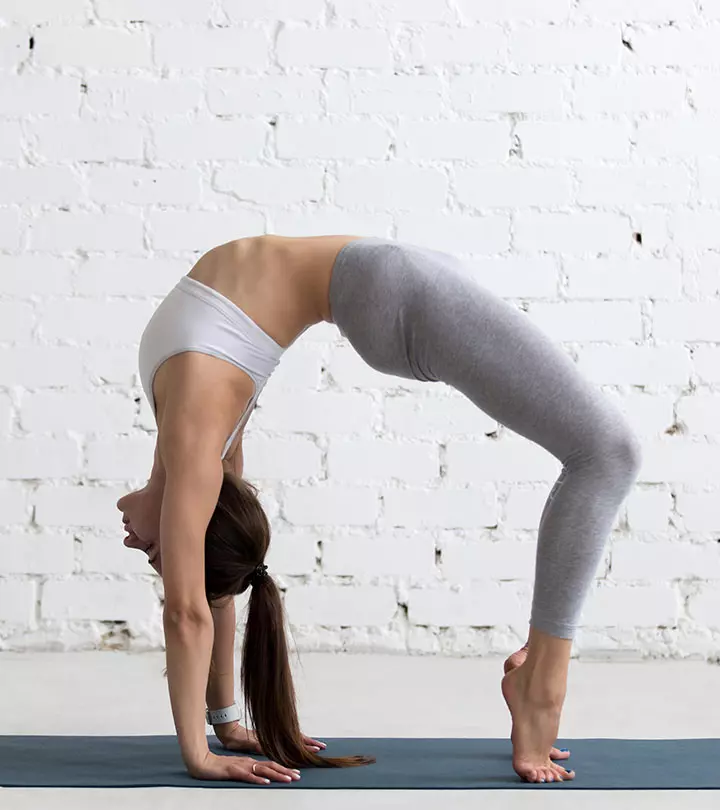







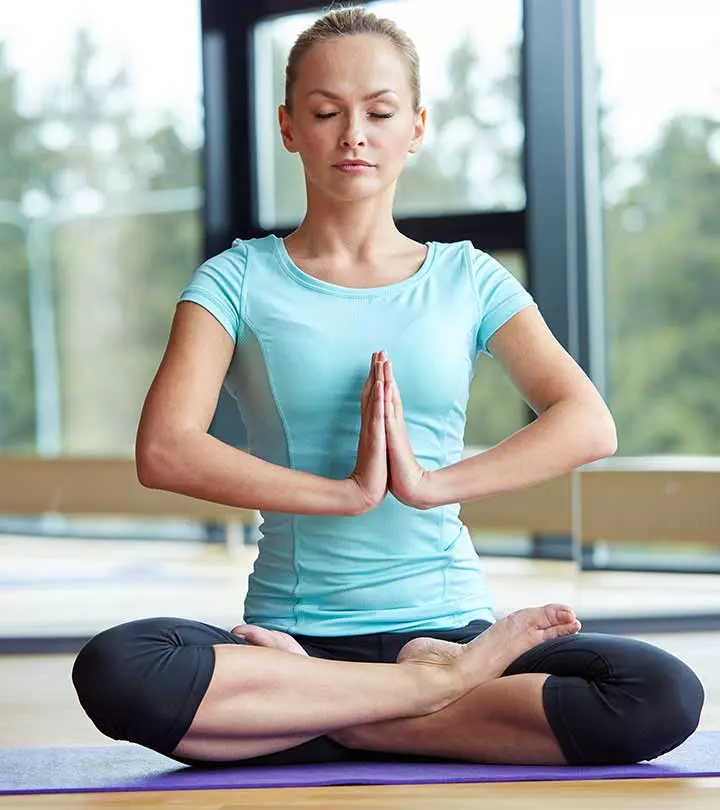






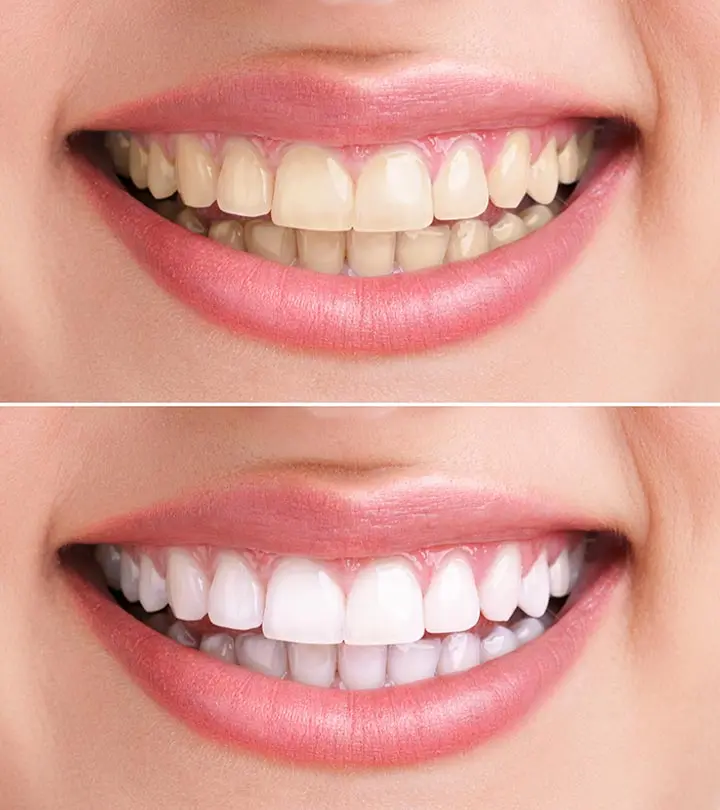





Community Experiences
Join the conversation and become a part of our empowering community! Share your stories, experiences, and insights to connect with other beauty, lifestyle, and health enthusiasts.